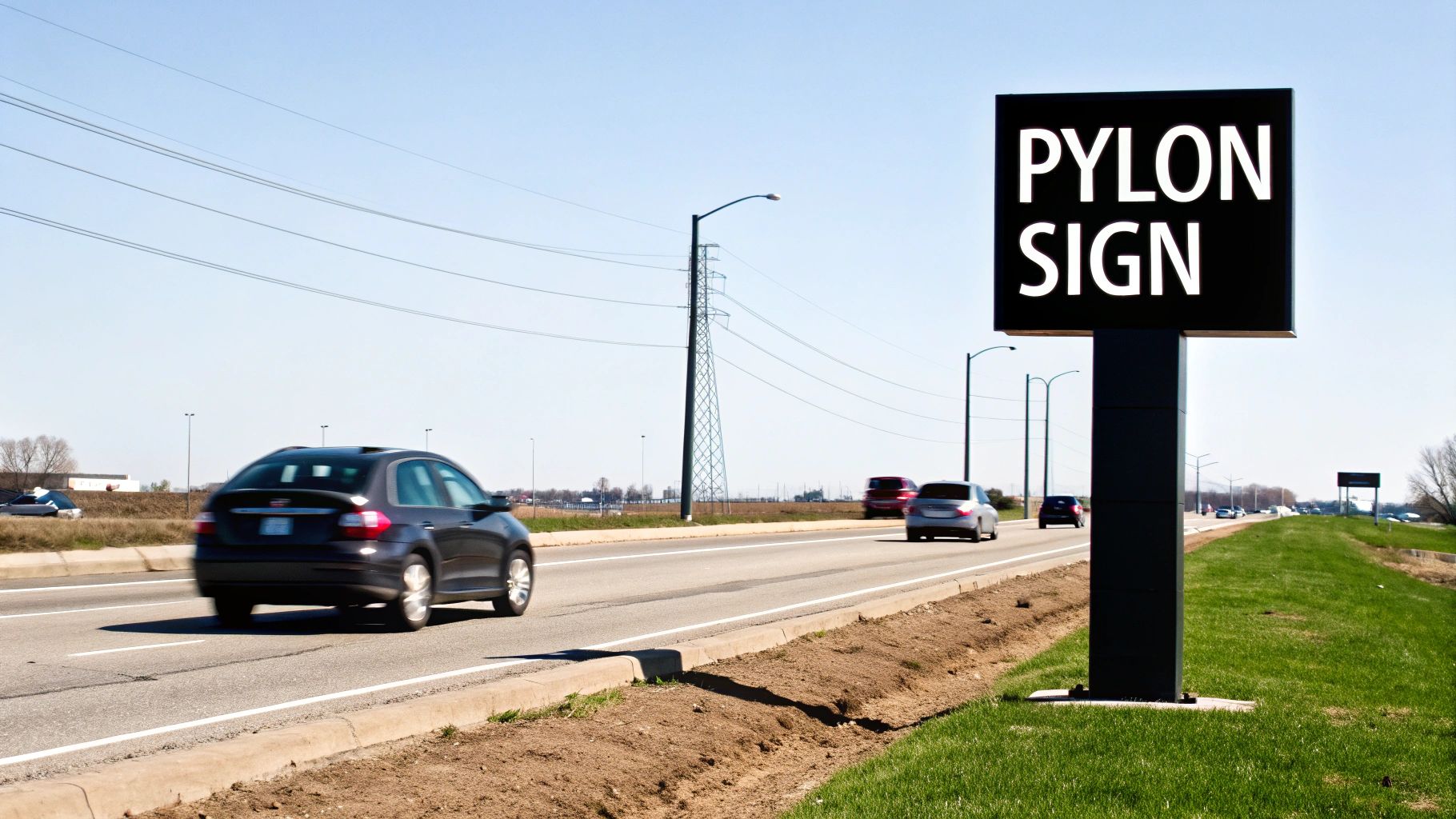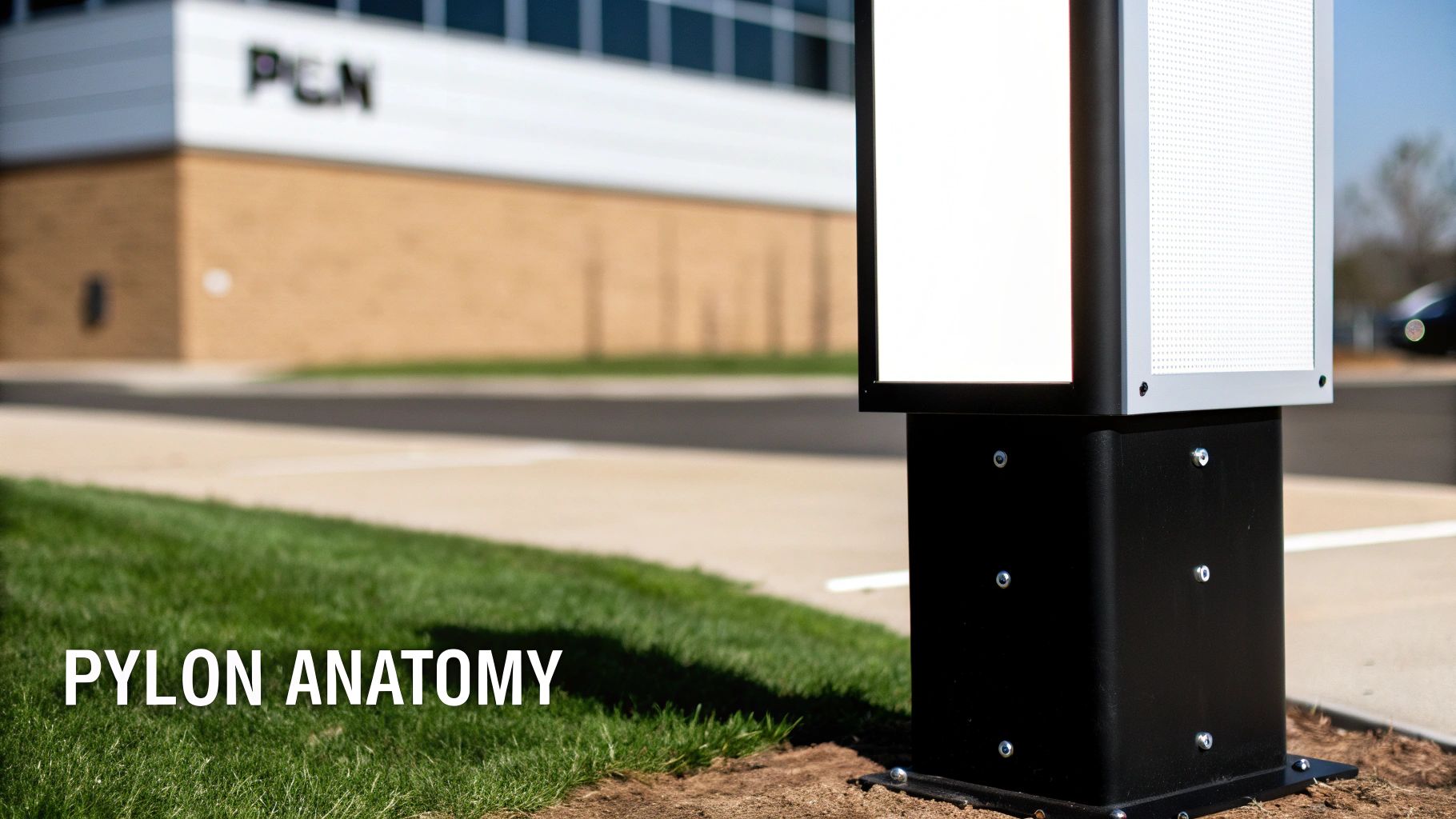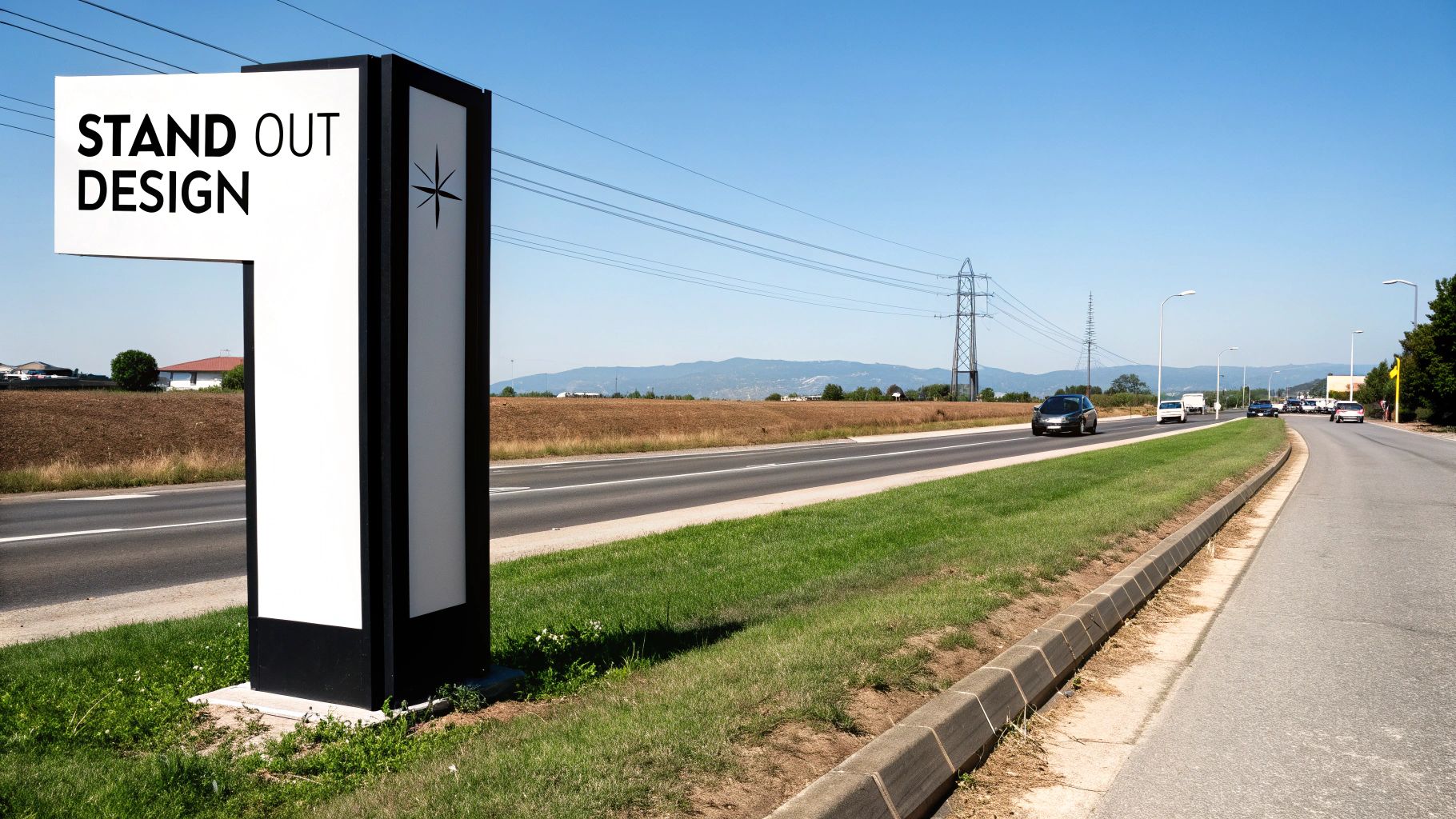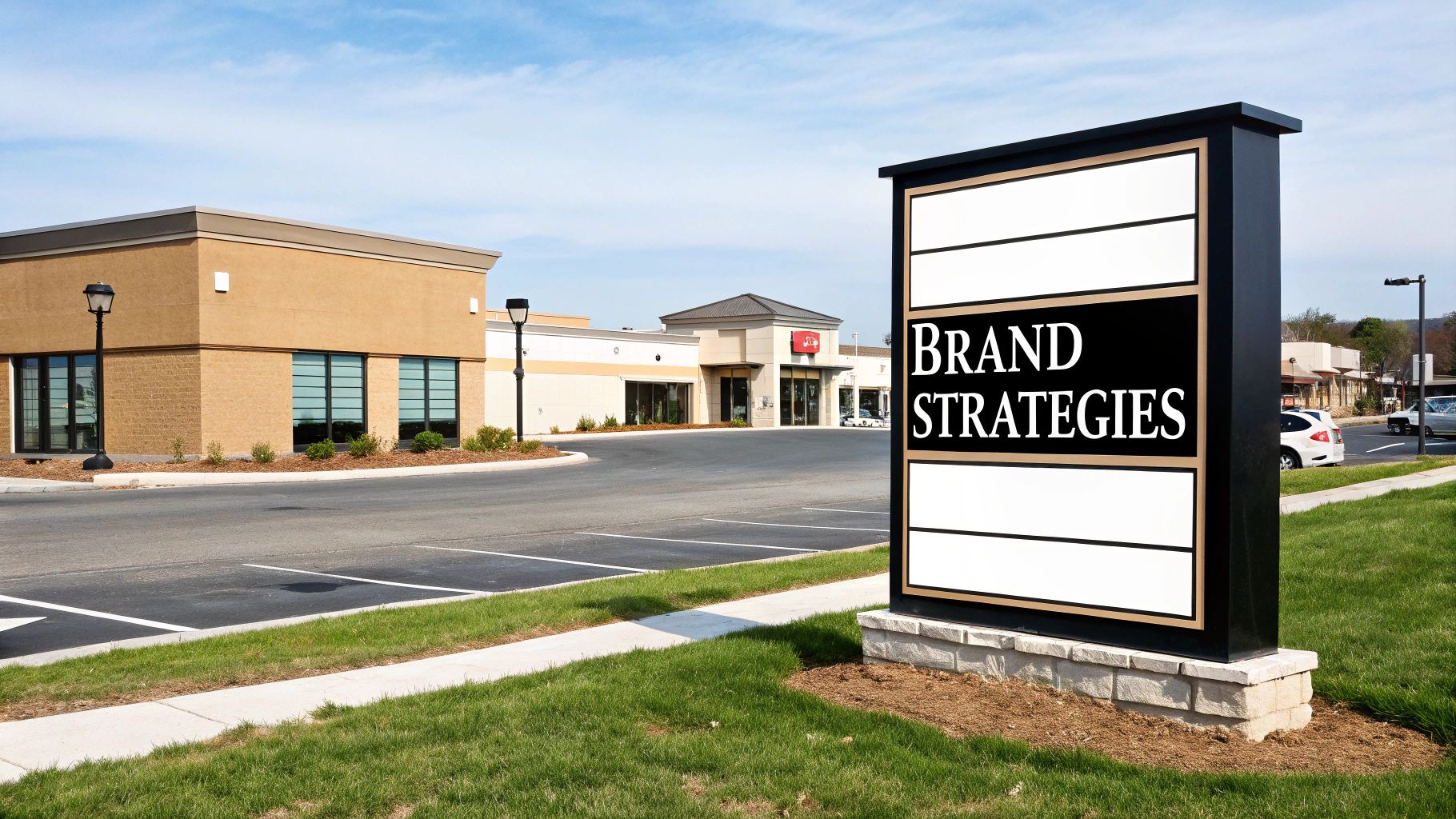Think of a pylon sign as a lighthouse for your business. It's a tall, freestanding structure, usually propped up by one or two huge poles, designed to cut through the visual noise and be spotted from far away. Its entire job is to provide maximum visibility and guide customers right to your doorstep long before they actually arrive.
What Is a Pylon Sign and How Does It Work

Picture yourself driving down a busy highway, surrounded by a sea of buildings and distractions. A pylon sign is the beacon that rises above it all, announcing your location with authority. Unlike their shorter cousins, monument signs, which sit close to the ground, pylon signs are built for height, often towering anywhere from 20 to 80 feet tall.
This elevation is their superpower. It allows your brand to be seen over trees, other buildings, and the endless stream of competing advertisements, making it incredibly easy for first-time visitors to find you. For example, a restaurant located in a crowded shopping strip can use a pylon sign to announce its presence to hungry drivers well before they reach the entrance, giving them ample time to decide and turn in.
Key Characteristics of Pylon Signs
While they share some DNA with other signage, pylon signs are a distinct breed. They are carefully engineered tools of communication, each with a specific purpose. To get a better sense of where they fit in, it’s helpful to explore the different types of outdoor business signs and see how each one plays a unique role.
Here’s a quick rundown of the features that make a pylon sign what it is:
- Freestanding Structure: They stand on their own, completely independent of any building, supported by one or two massive poles.
- Illumination: The vast majority are lit from within, usually with modern LEDs, to keep them visible 24/7.
- Multi-Tenant Capability: Perfect for shopping plazas and business parks, they can be designed with separate, illuminated panels for each business.
To put it simply, here’s a quick overview of what defines these signs.
Pylon Sign at a Glance
| Attribute | Description |
|---|---|
| Structure | A tall, freestanding sign supported by one or two poles. |
| Height | Typically ranges from 20 to 80 feet, built for long-distance visibility. |
| Location | Positioned near busy roads, highways, and commercial centers. |
| Lighting | Almost always internally illuminated, often with LEDs, for 24/7 visibility. |
| Best Use Case | Shopping centers, business parks, car dealerships, gas stations, hotels. |
These core features combine to create a powerful landmark that drives traffic and solidifies your presence in a crowded market.
Why Pylon Signs Stand Tall Above the Rest
Pylon signs became a roadside staple for one simple reason: they work. Long before anyone was talking about marketing funnels, businesses needed a dead-simple way to shout their presence to travelers and locals. These towering structures solved the fundamental problem of being seen in a crowded world.
Their biggest advantage is pure, unfiltered height. In a sea of low-profile buildings and competing storefronts, a pylon sign physically rises above the noise. It acts as a permanent beacon for your brand, turning your location into a landmark that guides customers right to your door. This isn't just about getting noticed—it's about making it easy for people to find you.
The Power of Advanced Visibility
Imagine a busy retail strip where every business is fighting for attention at eye level. A pylon sign completely sidesteps that ground-level battle. By lifting your message into the sky, you grab the attention of drivers long before they’re right in front of your entrance, giving them plenty of time to decide to pull in.
This kind of advance notice is a game-changer for businesses that depend on drive-by traffic, like gas stations, hotels, and fast-food chains. The sign essentially announces you're open for business from a quarter-mile away, making you the obvious choice for motorists needing your services.
For businesses tucked just off a major highway or set back from the road, a pylon sign isn’t just an advertisement—it’s a lifeline. It bridges the physical gap between your front door and the flow of potential customers, ensuring you’re never missed.
The impact of these signs on American business is huge. Around 385,000 businesses in the U.S. use them, and companies spend over $500 million a year on their manufacturing and upkeep. You can read more about their role at MegaSignInc.com.
Today’s pylon signs often include dynamic messaging, making them even more powerful. To see how technology is taking these classic structures to the next level, check out our guide on digital sign LED options. By pairing height with bright, clear messaging, pylon signs cement your presence and make sure you stand out.
Anatomy of a High-Impact Pylon Sign
A great pylon sign is more than just a big box on a stick—it's a carefully engineered structure that blends form and function. Its whole job is to lift your brand above the chaos of traffic and get you noticed. Think of a gas station sign on a busy highway; its height is what allows it to cut through the clutter and guide drivers in from a distance.
So, what holds these giants together? At a basic level, every pylon sign has a few core parts working in sync:
- Support Poles: These are the backbone of the sign, anchoring the entire structure to the ground and engineered to withstand serious wind loads.
- Sign Panels: This is the canvas where your brand comes to life. They can be designed for a single business or divided up to serve multiple tenants.
- Lighting Systems: Crucial for round-the-clock visibility, these systems ensure your message shines bright, day or night.
- Frames and Housing: This protective shell is built from tough, weather-resistant materials to keep everything safe and looking sharp.
This construction is what makes a pylon sign different from other freestanding options, like shorter monument signs. It's the one- or two-pole support system that elevates the main sign cabinet high above eye level, making it impossible to miss.
Durable Materials for Lasting Performance
You can't just use any old material when you're building something this big. Steel frames provide the raw strength needed to stand firm against high winds, while aluminum is often used for its corrosion resistance and lighter weight. Using aluminum can make the installation process a bit easier and often means less long-term maintenance.
If you're interested in learning more about material choices, check out our guide on Aluminum Composite Signage.
| Material | Benefit |
|---|---|
| Steel | High structural integrity |
| Aluminum | Lightweight and rust-proof |
Lighting Options for 24/7 Visibility
Gone are the days of buzzing fluorescent tubes. Modern pylon signs rely almost exclusively on LED modules to deliver bright, even lighting that grabs attention. They’re far more energy-efficient and last significantly longer than any older technology, saving you money in the long run.
There are a few ways to light things up:
- Internal LED Strips: Placed inside the sign cabinet, they create a uniform, brilliant glow across the entire panel.
- Backlit LEDs: These are perfect for highlighting raised letters or logos, creating a sophisticated "halo" effect.
- Changeable Digital Displays: For ultimate flexibility, an integrated LED screen lets you update messaging on the fly.
“Consistent lighting makes your sign a constant beacon, guiding customers at all hours.”
For example, adding smart features like dimming controls allows the sign to adjust its brightness automatically, ensuring it’s perfectly visible in broad daylight without being overwhelming at night. This practical feature not only saves energy but also ensures your sign is always compliant with local brightness ordinances.
Sign Formats and Flexibility
Pylon signs aren't a one-size-fits-all solution. They can be designed as a simple, elegant marker for a single business or as a massive multi-tenant directory for a shopping center or office park.
This flexibility is their greatest strength. A single-tenant sign keeps the focus entirely on your brand, while multi-tenant pylons with segmented panels help visitors navigate a larger complex. And if you add a digital screen, you can instantly swap out tenant names, announce sales, or display community messages.
This versatility ensures your sign doesn't just get seen—it stays relevant.
Designing a Pylon Sign That Gets Noticed
A great pylon sign isn't just about being big; it’s about being smart. The design process starts long before you pick out colors or fonts—it begins with the most critical factor: location. The right spot ensures your sign has clear sightlines, making it impossible for traffic to miss without being blocked by trees or other buildings.
Once the placement is locked in, the design has to be instantly readable. Drivers only have a few seconds to register your message, so clarity is everything. That means using large, clean fonts and high contrast between the text and the background. Think bold black or white letters on a simple, solid color. It will always beat a busy, low-contrast design. The goal is communication at a glance.
Key Design Principles
To get a sign that actually works, you have to nail these foundational elements. Each one helps turn a simple structure into a powerful marketing tool.
- Bold Branding: Your logo needs to be front and center, acting as a visual shortcut for your brand. It reinforces recognition every single time someone drives past.
- Minimalist Text: Keep the words to a minimum. Seriously. Your business name and maybe one key service are all you need. Too much text just becomes a blur at 50 mph.
- Consistent Colors: Stick to your established brand colors. This builds a cohesive identity and makes your business instantly familiar to repeat customers.
Think of your pylon sign as a billboard with a permanent address. Its design must be simple, direct, and memorable enough to make a lasting impression in a matter of seconds.
Navigating Regulations and Permits
Before you get too attached to a design, you have to deal with local zoning laws. Municipalities have strict regulations covering everything from sign height and size to placement. Sorting through these requirements and getting the right permits is a make-or-break step that prevents expensive delays or being forced to start over.
This is where expert help is a game-changer. A professional sign company handles the entire permitting headache, making sure your design is compliant from day one. They can also advise you on how to maximize your sign's impact within the legal limits, perhaps by using eye-catching features like 3-D letter signs that add depth and visibility. It’s the practical way to ensure your sign gets noticed for all the right reasons.
How Pylon Signs Drive Real Business Growth
A well-designed pylon sign is so much more than a landmark. It's your hardest-working salesperson, pulling in customers around the clock. Its sheer size and presence cut through the noise, translating directly into more foot traffic and stronger brand recall.
Think of it this way: for any business that relies on impulse visits—like a hotel, restaurant, or gas station—a pylon sign is a game-changer. It gives a driver on a busy road plenty of time to see you, register who you are, and make a safe decision to pull in. Without it, you're just another blur in their peripheral vision.
Turning Visibility into Profitability
The link between being seen and getting paid is undeniable. In fact, studies show that adding a large, visible sign can boost a business's annual sales by an average of 7.7%. That impact is even bigger for a new business trying to carve out a spot in a crowded market.
A brightly lit pylon sign also keeps advertising for you long after you've locked up. This 24/7 visibility hammers your brand into the minds of everyone who drives by, building the kind of familiarity that leads to trust. The next time they need what you sell, your business is the first one that comes to mind.
By becoming a landmark, a pylon sign does more than just show people where you are—it solidifies your business as a permanent, reliable fixture in the community.
A Cornerstone of Local Marketing
A towering pylon sign should be a key part of your toolkit. It's one of the most effective and proven local business marketing strategies out there because it signals stability and professionalism.
For shopping centers with multiple businesses, these signs become an essential directory, making life easier for customers and giving every tenant a boost.
Whether it’s showing off a sale on a digital display or just lighting up your logo against the night sky, the mission is the same: you are actively pulling customers off the street and creating sales that simply wouldn't have happened otherwise. That’s how a structure of steel and light fuels real, lasting growth.
Pylon Sign Strategies from Successful Brands
The smartest brands don't just throw up a sign and hope for the best. They treat their pylon signs as a strategic tool to grab the attention of a very specific audience. If we look at how different businesses do it, we can pull out some practical lessons that actually get results.
Think about the last time you were driving on the highway, watching the fuel gauge drop. What’s the first thing you searched the horizon for? That giant gas station sign. These guys are masters of using height and simple, bold messaging—just a logo and a price—to pull drivers off the road. Their entire strategy is built around pure, functional visibility for an audience moving at 70+ mph.
Lessons from Retail Centers
Shopping plazas and retail parks offer another perfect case study in pylon sign strategy. Their big multi-tenant signs are brilliant examples of clarity and organization.
- Smart Hierarchy: The plaza’s name or a major anchor store usually gets the biggest panel at the top, giving your eyes a clear place to start.
- Clean Uniformity: Every tenant panel is typically the same size and format. This keeps the sign from looking like a cluttered mess and lets shoppers quickly scan for the store they need.
- Strategic Placement: You’ll always find these signs at the main entrances to the parking lot, where they act as a directory to guide traffic and stop people from driving around lost.
The real job of a multi-tenant pylon sign is to make finding a store completely effortless. By organizing all that information cleanly, it improves the customer experience before they’ve even parked the car, which helps every single business in the center.
Adapting These Strategies for Your Business
What all these examples show is that the best pylon sign is designed specifically for its audience and its location. A massive car dealership might use a brightly lit sign to project a feeling of authority and scale, while a hotel is more focused on being a warm, welcoming beacon for tired travelers.
Once you truly understand what is a pylon sign and its core purpose—maximum visibility—you can start designing one that really works for you.
Answering Your Pylon Sign Questions
Putting up a pylon sign is a big move, so it’s smart to have questions. Naturally, one of the first things business owners ask about is the price, which can swing quite a bit depending on the sign's size, the materials we use, and whether you go for a classic static sign or a modern digital one.
The other big question is always about the timeline. Getting a pylon sign up and running isn't a quick job, mainly because of the critical step of getting local permits. That process alone can take weeks or even months, depending on how your local government handles things. If you're curious about what that involves, you can learn more about typical sign permit requirements and why they're so important.
Static vs. Digital Displays
Trying to decide between a timeless static sign and a flexible digital display is a common crossroads. A static sign gives you that permanent, reliable branding that people come to recognize. On the other hand, a digital sign lets you change your message on the fly for special sales, events, or holiday promotions. It really boils down to your budget and what you want your sign to accomplish long-term.
So, what about keeping it in good shape? A little bit of upkeep goes a long way in protecting your investment.
Simple things like routine cleaning to get rid of dirt and grime, plus the occasional check-up on the lights and electrical parts, will keep your pylon sign looking sharp and working perfectly for years.
Staying on top of this basic maintenance helps you catch small problems before they turn into big, expensive repairs, making sure your sign stays a powerful landmark for your business.
Ready to make your business a landmark? On Display Signs, Inc. designs, fabricates, and installs high-impact pylon signs that get you noticed. Start your project today at https://www.ondisplaysigns.com.







